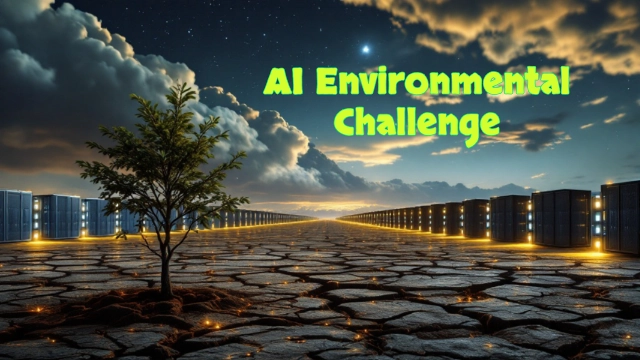Artificial Intelligence (AI) is everywhere. It’s in the apps we use daily, the systems that power industries, and even the tools designed to tackle humanity’s biggest challenges. From Netflix predicting your next binge-worthy show to life-saving medical diagnoses powered by AI analysis, it often feels like this technology is straight out of a sci-fi movie. And let’s be honest, it’s pretty amazing. But here’s the kicker—beneath the shiny veneer of algorithms and predictions lies an inconvenient reality: AI has a substantial environmental cost. The more sophisticated and widespread it becomes, the more energy it demands, leaving a growing carbon footprint in its wake.
If you’ve ever marveled at how effortlessly your phone recognizes your face or how accurately Spotify nails your music taste, consider what fuels these miracles. Spoiler alert: it’s not magic—it’s data, computation, and energy. A lot of energy. So, what’s the real environmental price of this modern marvel? Let’s pull back the curtain and explore.
The Rise of AI: Amazing, But at What Cost?
From a future idea, AI has become a smooth aspect of our everyday existence. It’s so integrated that many of us don’t even realize we’re using it. Think about it: every time you ask Siri for the weather, let Google Maps guide you through traffic, or let YouTube auto-play another video that somehow hits the mark, AI is quietly at work. It’s also revolutionizing fields far beyond personal convenience. AI is helping scientists predict weather patterns, improving crop yields to combat hunger, and even streamlining disaster relief efforts in crisis zones.
A Double-Edged Sword of Innovation
This transformative power is a testament to how far technology has come. AI is reshaping industries, solving problems once thought impossible and paving the way for a smarter future. But here’s the catch: this technological leap forward is built on massive amounts of data and computation. That means running AI systems—especially sophisticated ones—requires tremendous energy.
Energy use isn’t just an abstract concept; it translates into real-world environmental consequences. Every time AI processes data or trains its models, it consumes electricity. A large portion of this energy comes from fossil fuels, which leads to carbon emissions. The more advanced AI is, the greater the energy demand and carbon footprint.
How AI Works: Understanding the Energy Hunger
We need to unpack how AI operates to grasp why it has such a high environmental cost. At its core, AI uses machine learning (ML), a method where computers are trained to recognize patterns, make decisions, or predict outcomes. This training isn’t a one-off task; it’s an intensive process involving repeatedly analyzing enormous datasets to refine the model’s accuracy.
The Mechanics of AI: Training is the Name of the Game
Think of AI training as preparing for a marathon. A basic AI model might require a quick jog around the block—low effort and minimal resources. But what are the high-performing models we rely on today? They’re more like ultra-marathoners, pushing their computational limits. These advanced systems require days, weeks, or even months of continuous training on powerful machines. This process involves performing millions—sometimes billions—of calculations, and that requires serious energy.
Scaling Up: Bigger Models, Bigger Costs
AI isn’t just about training models; it’s about scaling them to handle increasingly complex tasks. For example, OpenAI’s GPT-3—a cutting-edge language model—needed hundreds of GPUs running around the clock for weeks to complete its training. The result? An exceptionally intelligent system, yes, but also one that guzzled a staggering amount of electricity. And remember, these GPUs aren’t running on pixie dust; they’re powered by electricity from data centers, which are often reliant on non-renewable energy sources.
The Marathon of Training AI
To make it more relatable, let’s stick with the marathon analogy. Training an AI model is like preparing for a race—but on a superhuman level. A beginner might run a few miles, stretching their limits but not consuming much energy. Meanwhile, training a state-of-the-art AI model? That’s like an elite athlete running multiple marathons back-to-back, day after day.
This AI “athlete” is consuming resources every step of the way. Instead of protein bars and electrolytes, it needs computational power and electricity. And the bigger the model, the more grueling the race. AI models today are sprinting through uncharted computational territory, requiring tens of thousands of GPU hours. Each hour draws electricity, and when you multiply that by the energy needs of modern data centers, you start to see just how staggering the environmental cost becomes.
The Never-Ending Race
Here’s the kicker: AI’s energy use doesn’t stop after the training phase. Even when the model is ready to roll, it keeps consuming power every time it’s used. Whether it’s recommending a movie, translating text, or running a chatbot, those servers are still crunching numbers in the background. It’s like the marathon runner never gets to rest—always on call, always burning energy.
AI has undeniably changed the game, offering solutions that were once beyond our reach. But as we marvel at its capabilities, we must also confront the environmental reality. The energy hunger of AI isn’t just a technical challenge; it’s a global issue that demands attention. If we’re serious about building a sustainable future, addressing AI’s carbon footprint isn’t optional—it’s essential.
The Carbon Cost: Why AI’s Energy Use is a Problem
AI’s immense appetite for energy doesn’t come without consequences—it directly translates into carbon emissions. While its groundbreaking capabilities mesmerize us, the environmental toll is sobering. Let’s break it down into bite-sized chunks:
1. Training Models Eats Energy
Training an advanced AI model isn’t just expensive regarding computational resources; it’s a major energy drain. For comparison, the lifetime carbon dioxide emissions from training a single large model can equal the emissions from five gas-powered cars—yes, including manufacturing. This isn’t just a hypothetical; it’s backed by research that quantifies the environmental burden of powering the thousands of GPUs needed for these marathon training sessions.
Each GPU performs billions of calculations, consuming electricity at a relentless pace. And remember, most of that energy doesn’t come from clean sources. In many regions, it’s still generated from coal, natural gas, or oil, meaning every watt used leaves a carbon trail. As AI models get larger and more complex, the energy required scales exponentially, making training a single model an environmental event in itself.
2. Data Storage Isn’t Free
AI thrives on data, but all that data needs a home. Enter data centers—the digital warehouses where servers store, process, and retrieve the massive datasets AI models rely on. These facilities operate 24/7, sucking up electricity to keep thousands of servers humming along. But that’s not all—they also require robust cooling systems to prevent overheating. And cooling a data center? It’s like running an industrial-sized air conditioner non-stop all year round.
The environmental cost of data storage is often overlooked, but it’s a significant piece of the puzzle. The need for more prominent and more energy-intensive data centers grows as AI systems consume ever-larger datasets to learn and improve. For perspective, some of the world’s largest data centers use as much electricity as a small town. Multiply that by the thousands of centers worldwide, and you’re looking at a staggering energy demand.
3. Running Models Adds Up
Here’s a misconception: once an AI model is trained, the energy demands taper off. Unfortunately, that’s far from the truth. Every time you interact with an AI-powered tool—be it a chatbot, a recommendation engine, or a translation app—the system taps into data centers to process your request. These seemingly small, everyday tasks require significant computational effort when scaled to millions (or billions) of users.
Think about it like this: when you ask Alexa to play your favorite song, she’s not just sitting there with a simple playlist. She’s sending your request to a server, which processes it in real time, finds the best match, and delivers it back to your device. That back-and-forth consumes energy, and when done on a massive scale—think Netflix or Google—it adds up to an astronomical amount of electricity use.
4. Hardware’s Hidden Impact
AI hardware often gets a free pass in environmental discussions, but it’s a critical component of the carbon cost. GPUs and TPUs are the engines behind AI, performing the complex computations that make machine learning possible. However, building this specialized hardware comes with its own environmental baggage.
First, manufacturing GPUs and TPUs requires mining rare earth materials like cobalt and lithium. Mining not only depletes finite resources but also causes habitat destruction, soil erosion, and water contamination. Once the materials are extracted, the production process involves energy-intensive refining and assembly, which adds another layer of carbon emissions.
Then there’s the issue of obsolescence. AI hardware becomes outdated quickly, often replaced within a few years. This rapid turnover contributes to the growing problem of e-waste—tons of discarded electronics that are difficult to recycle and often end up in landfills, leaking toxins into the environment.
AI’s Paradox: Helping and Hurting the Planet
Here’s where things get complicated. While AI contributes to environmental problems, it’s also a vital tool for addressing them. This duality makes AI both a challenge and a potential solution.
How AI Helps the Planet
- Optimizing Energy Grids
AI is transforming how we manage energy. Analyzing consumption patterns helps utility companies predict demand more accurately and distribute energy more efficiently. This reduces waste and lowers emissions by minimizing reliance on peak-demand fossil fuel plants. - Monitoring Deforestation
AI-powered satellite imagery analysis is a game-changer for conservation efforts. These systems detect illegal logging, monitor forest health, and provide real-time updates to environmental organizations, enabling faster and more targeted interventions. - Streamlining Supply Chains
Many companies are using AI to make their operations more efficient. For example, AI algorithms can optimize shipping routes, reduce excess inventory, and minimize waste, all of which translate into lower carbon footprints.
The Balancing Act: AI’s Growth vs. Sustainability
As AI continues to expand, its energy demands will grow. The challenge lies in leveraging AI’s potential for good without letting its environmental cost spiral out of control. That means innovating smarter, greener technologies while using AI to amplify sustainability efforts.
The bottom line? AI is like a powerful tool in the fight against climate change—but only if we use it responsibly. By balancing its development with eco-conscious practices, we can unlock its full potential without compromising the planet.
Solutions: How to Tackle AI’s Carbon Footprint
Reducing the environmental impact of AI is not only possible—it’s necessary. Making AI sustainable will take a coordinated effort from corporations, governments, researchers, and even individual users. Here are some of the key ways we can address the challenge:
1. Shift to Renewable Energy
Data centers are the beating heart of AI, powering everything from model training to real-time services like virtual assistants and video streaming. However, these energy-hungry facilities often rely on electricity from fossil fuels. They can drastically cut their carbon emissions by switching to renewable energy sources such as wind, hydroelectric, and solar.
Big Players Leading the Charge
Tech giants are already taking bold steps toward greener energy use. Google, for example, has been carbon-neutral since 2007 and aims to operate all its data centers on renewable energy 24/7 by 2030. Microsoft is going even further, pledging to be carbon-negative by the same year, Put otherwise, they will remove more carbon from the environment than they emit. Amazon, through its AWS (Amazon Web Services), is also heavily investing in renewable energy to power its global data centers.
The Ripple Effect
When industry leaders commit to renewable energy, they create a ripple effect. Smaller companies often follow suit, driven by competition or inspiration. Plus, these commitments help scale renewable energy infrastructure, making it more accessible and affordable for everyone.
2. Improve AI Efficiency
AI doesn’t have to be a resource hog. Researchers and developers are continuously finding ways to make AI models more energy-efficient without sacrificing their performance. These improvements involve rethinking how AI systems are built and trained.
Techniques for Smarter AI
- Pruning: This technique involves removing unnecessary parts of a neural network, much like trimming a tree. The model becomes lighter and less energy-intensive by cutting away the redundant sections.
- Quantization: This method reduces the precision of the numbers used in AI calculations, allowing models to run faster and consume less power without compromising accuracy.
- Knowledge Distillation: Larger, complex models can train smaller models to mimic their behavior, effectively passing on their “knowledge” without the hefty energy demands.
Think of It Like an AI Diet
Improving efficiency is like putting AI on a diet—not starving it, but trimming the excess to make it leaner and more focused. This reduces energy consumption and cuts costs for companies, making it a win-win.
3. Promote Recycling and Circular Tech
AI’s reliance on specialized hardware, like GPUs and TPUs, poses another environmental challenge. These components are built using rare earth materials, which are resource-intensive to mine and manufacture. Additionally, older gear soon becomes obsolete due to the rapid speed of technological innovation., contributing to the growing e-waste problem.
A Circular Economy for Tech
To combat this, companies and governments can:
- Design recyclable components: Hardware should be easy to dismantle and recycle, recovering valuable materials like cobalt and lithium.
- Encourage refurbishment: Old GPUs and servers can often be refurbished for secondary use, extending their lifespan.
- Establish recycling programs: Tech companies can set up buy-back or recycling initiatives to ensure discarded hardware is processed responsibly.
Individual Responsibility
By properly discarding their electronic equipment and patronizing companies that put sustainability first, consumers can also contribute. Imagine a future where every AI chip is part of a closed-loop system, reused and repurposed instead of discarded.
4. Encourage Accountability
Transparency is a powerful tool for change. By demanding accountability from tech companies about the environmental impact of their AI systems, we can drive industries to adopt more sustainable practices.
What Consumers Can Do
- Ask questions: Inquire about a company’s carbon footprint and how they manage their data centers.
- Support green businesses: Select goods and services from organizations that prioritize sustainable practices and renewable energy.
- Raise awareness: Use social media and other platforms to highlight the environmental challenges of AI and advocate for greener solutions.
Corporate Responsibility
When companies disclose their environmental data—such as energy use and carbon emissions—they’re not just being transparent but setting benchmarks for improvement. Public accountability fosters innovation and encourages organizations to compete in sustainability, not just performance.
5. Policy and Regulation
Governments play a dynamic role in establishing the framework for long-term AI. By setting rules and incentives, they can ensure that environmental considerations are baked into the growth of AI technologies.
Setting Energy Standards
Governments can enforce energy efficiency standards for data centers, requiring them to adopt greener cooling systems, optimize server usage, and transition to renewable energy sources.
Offering Incentives
Tax breaks or subsidies for companies that invest in renewable energy or develop energy-efficient AI systems can accelerate adoption. For example, grants for research into sustainable hardware design could lead to breakthroughs in low-energy AI technologies.
Global Cooperation
AI’s environmental impact is a global issue, and international collaboration will be key. Policies like Europe’s Renewable Energy Directive, which encourages businesses to transition to clean energy, could serve as a blueprint for other regions.
The Role of Collaboration: Companies, Governments, and Individuals
The challenge of reducing AI’s carbon footprint isn’t something any one group can tackle alone. Companies must innovate, governments must regulate, and individuals must advocate and make informed choices. Together, these efforts can create a future where AI and environmental sustainability go hand in hand.
What You Can Do Right Now
- Turn off devices when not in use to reduce unnecessary energy consumption.
- Limit streaming quality when high definition isn’t necessary (goodbye, autoplay in 4K).
- Advocate for greener practices in your workplace or community.
- Support companies that prioritize sustainability.
A Greener Future for AI
Implementing these fixes guarantees that AI remains a transformative force without compromising the planet’s health. With renewable energy, more intelligent technologies, and collective action, we have the tools to make AI sustainable. It’s not just about solving today’s problems—it’s about building a future where technology and the environment thrive together.

What You Can Do as a Consumer
Feeling like your actions won’t make a dent? Don’t sell yourself short. While large corporations and governments hold much of the responsibility, individual choices can collectively drive significant change. Here’s how you can play your part:
1. Be Mindful of Your AI Usage
Every time you use an AI-powered service—whether it’s a virtual assistant like Siri or Alexa, a recommendation engine on Netflix, or a search query on Google—you’re triggering data centers to work behind the scenes. While these conveniences make life easier, they also come at an environmental cost.
Practical Steps:
- Limit unnecessary queries: Do you really need to ask Alexa to play white noise or check the weather when a quick glance outside would suffice?
- Adjust streaming quality: Watching a movie in ultra-HD is great, but for casual viewing, the standard definition uses significantly less energy.
- Think twice before “always-on” devices: Voice assistants and smart gadgets that are perpetually listening consume power even when idle. Turn off devices when not needed.
By making small changes in how and when you use AI, you can reduce your digital carbon footprint without sacrificing much convenience.
2. Support Sustainable Companies
Where you spend your money matters. Businesses that put importance on sustainable practices and renewable energy are aware when customers recognize and reward their efforts. Every dollar you spend sends a message about the kind of future you want to support.
How to Identify Green Companies:
- Look for businesses with strong sustainability commitments, such as pledges to become carbon-neutral or use renewable energy.
- Check for certifications or transparency reports that disclose environmental impact.
- Research if the company actively invests in eco-friendly innovations, like energy-efficient data centers or recycling programs.
For example, supporting platforms like Ecosia, a search engine that plants trees with its profits, or companies like Google and Microsoft, which are pushing renewable energy for their AI operations, can amplify the impact of your choices.
3. Raise Awareness
Advocacy starts with awareness. Most people don’t realize the environmental cost of their favorite AI-driven tools and services. By starting conversations, sharing articles, and supporting campaigns for greener AI, you can help educate others and create a ripple effect.
Ways to Raise Awareness:
- Use social media for good: Share facts about AI’s carbon footprint or highlight companies leading the charge in sustainability.
- Join or start community initiatives: Encourage local governments or organizations to adopt policies that promote renewable energy and energy-efficient tech.
- Push for transparency: Ask your favorite brands to disclose their environmental impact and commit to greener practices. Public accountability can drive meaningful change.
A Call for Smarter AI
AI is a technological wonder, reshaping how we live, work, and solve problems. But let’s not ignore the elephant in the room—it’s a resource-intensive powerhouse that needs to evolve responsibly. The good news? More thoughtful, greener AI isn’t just possible; it’s already in progress.
Imagine a future where AI systems predict energy demand to optimize grids, help scientists combat climate change, and power innovations in sustainability—all without leaving a massive carbon footprint. That’s the sweet spot we need to hit.
But getting there requires a collective effort, and developers must design energy-efficient systems. Companies must invest in renewable energy and recycling programs. Governments should enforce policies that prioritize sustainability. Consumers—you—play a vital role in supporting these initiatives and holding stakeholders accountable.
Final Thoughts: The Road Ahead
AI isn’t going anywhere, and let’s be honest—that’s a good thing. Its potential to revolutionize industries, solve seemingly impossible problems, and improve lives is boundless. However, this potential comes with a responsibility to ensure that progress doesn’t come at the expense of our planet.
By focusing on sustainable solutions, demanding transparency, and making conscious choices, we can steer AI toward a greener, more responsible future. Picture a world where AI doesn’t just help us become smarter but also ensures the planet remains livable for generations to come. That’s not just the ideal outcome; it’s the necessary one.
At the end of the day, building a smarter world means nothing if we’re not leaving behind a sustainable one. So let’s embrace AI as a force for good—not just for us, but for the environment too. After all, the legacy we create today will shape the world of tomorrow. The question is: are we ready to rise to the challenge?










